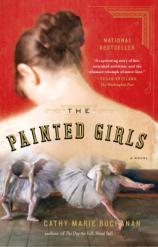The Painted Girls
Review
The Painted Girls
THE PAINTED GIRLS presents a historical view of the Parisian slums during the European Depression of the 1870s, a picture of poverty and desperation leading to a derelict culture.
We are presented a very artistic and poignant view of the fall of two innocents, both young dancers at one point and one possessing reasonable enough talent to gain elevated status as an opera ballerina. The girls struggle in their home lives and fight bitterly for the simple privilege of survival, half-starved and left to fend for themselves without protection from the harshness of the world, but never bereft of hope. This book explores the nature of the way lives unfold under pressure, the ideas behind human identity and morality, along with popular deterministic philosophies of the time surrounding the nature of fate. Is one’s life in fact changeable or determined by circumstance?
"Buchanan leaves it to readers to figure out whether or not these ballerinas were victims of their environment. Their stories, while heartbreaking, end positively because of the strength of their bond as sisters, leaving the healing power of love as a central theme. I would recommend THE PAINTED GIRLS as a great read for those who enjoy philosophical pursuits or gritty historicals."
The younger of these Parisian girls, Marie van Goethem, becomes famous for having been featured in some of Edgar Degas’ most well-known impressionist paintings and sculptures. A highly controversial work, Little Dancer Aged Fourteen,shows an odd perspective of an altered Marie, presented in 1881 at the Sixth Exposition of the Independent Artists in Paris. This “naturalistic impression” of a struggling young professional enjoying what might have been her finest hour as a dancer, even perhaps affording her a bit of admiration, emphasizes distinct monkey-like qualities in the girl, giving some impression that she was being treated as a medical specimen or altered as a hidden sleight.
Author Cathy Marie Buchanan questions Degas’ motives, particularly in his choice of form. This is all highly relevant to the novel since the famous artist chose to present depictions of the young dancer often in the nude and alongside criminals facing the gallows for murder. Buchanan intertwines the life stories of the sisters Antoinette and Marie with those of known criminals of the age, and also snapshots of Degas at work here and there, painting the little dancer, first in directing Marie to pose and then presenting works featuring her. Also presented in the book’s background is the play L’Assommoir by Emile Francois Zola, a famous playwright of the time whose naturalist themes and deterministic philosophies gained him great attention and made him rich --- although one has to question how many of his patrons actually understood what he was portraying.
In this story, Antoinette, a fierce and dignified young actress, performs in L’Assommoir as a lowly laundress. Interestingly, both Marie’s and Antoinette’s lives parallel events in the play --- Antoinette in life becomes the poor working girl who falls for the wrong man and sees her life ruined; is it because of poor choices or an original scarcity of choice? The parallels between Antoinette and Marie’s lives and events in the play create some seriously interesting reading material. While Antoinette is scarcely aware of the similarities, Marie (who is inherently a more virtuous and hopeful young girl) does recognize the significance at the outset and is deeply disturbed by it.
Alternating chapters are narrated by Antoinette and Marie, interspersed with articles from Le Figaro (France’s leading satirical newspaper of the 1800s). Much of the interesting content surrounds Degas and his odd character traits. The hard facts of life for these ballerinas are also incredibly engrossing and sometimes disturbing. One thing made perfectly clear about Marie is that her difficult life did seem to force her to accept Degas’ offer to pose, which included having to pose in the nude in front of a perfect stranger who might very well have abused her. Sadly, Marie’s story also includes succumbing to a “protector,” a common fate of ballerinas of the age who required some form of payment in order to stand any chance of rising up as a “petit rat” in the Paris Opera Ballet. The realities for these little “coquettes” were hidden from the public.
Buchanan leaves it to readers to figure out whether or not these ballerinas were victims of their environment. Their stories, while heartbreaking, end positively because of the strength of their bond as sisters, leaving the healing power of love as a central theme. I would recommend THE PAINTED GIRLS as a great read for those who enjoy philosophical pursuits or gritty historicals.
Reviewed by Melanie Smith on February 1, 2013
The Painted Girls
- Publication Date: February 4, 2014
- Genres: Fiction, Historical Fiction
- Paperback: 416 pages
- Publisher: Riverhead Trade
- ISBN-10: 1594632294
- ISBN-13: 9781594632297










